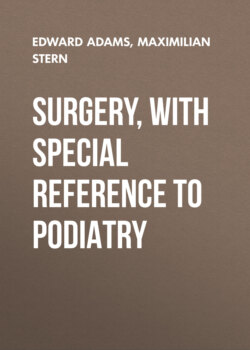Читать книгу Surgery, with Special Reference to Podiatry - Maximilian Stern - Страница 16
ОглавлениеIf there has been any loss of substance caused by the inflammation, it is restored by processes exactly similar in character to those in the repair of wounds.
Suppuration. Pus consists of a serum containing little or no fibrin and large numbers of leucocytes. There are also many cells, either dead or dying, which represent the waste thrown off from the tissues as a result of the inflammatory reaction. A purulent inflammation or suppurative inflammation, is one in which there is pus formation.
When suppuration occurs, the pus may make its way to a free surface, such as a mucous membrane, or may form an abscess, or may cause sloughing of the skin over the seat of inflammation, and so escape from the cellular spaces in the tissues.
Pus may be thrown off by a mucous membrane, without any actual breach of continuity. Diffuse infiltration of the tissues is the most dangerous form of suppuration.
In this variety of inflammation the exudate is brought into contact with the greatest possible extent of absorbent vessels, for as a surface of a sponge is greater than that of a bag, which would contain it, so the surface of these intercellular spaces is much greater than that of an abscess cavity filled by the same amount of pus. In this form the bands of cellular tissue, lying between and forming the boundaries of these spaces, remain intact, and the exudate is either absorbed into the circulation, or seeks escape through many punctate openings in the skin.
The entire skin of the part is frequently detached from the fascia by the sloughing of the subcutaneous tissues, before it gives way, and even when it finally yields to the necrotic process, the openings formed will be altogether too small in proportion to the extent of the disease beneath, so that healing is still further delayed.
Sloughing. Inflammation may be accompanied by sloughing or death of tissues. Gangrene, mortification or necrosis is a death of the tissue from any cause. The part which has died is designated as a slough.
When inflammation has subsided, granulation tissue forms on the living tissue, exerting pressure upon the slough, thus hastening its absorption or separation.
Chronic Inflammation. An interruption at some stage of resolution or suppuration and the continuance of mild symptoms constitutes a chronic state.
By chronic inflammation, we understand a long continuance of some or all of the changes seen in acute inflammation, but less in intensity, and an abnormal tendency to the production of new tissue.
Treatment. The general indications to be observed in the treatment of inflammation are: (1) to combat the congestion of the parts; (2) to relieve tension; (3) to give free issue to the products of inflammation; (4) to produce early separation of sloughs.
Very hot or very cold applications exert a beneficial and soothing effect upon inflamed areas.
Cold has the tendency to reduce tension by constricting the blood vessels thus diminishing the amount of blood supplied. In an infected area the reproduction and development of bacteria are checked, and suppuration is frequently aborted.
Heat has the effect of dilating the blood vessels and hastens repair in bruised, strained, or torn tissues. This is a variety of hyperemia treatment which is especially useful in the absence of bacteria. In infected areas the growth of bacteria, and increased pus formation, would be encouraged and heat is contraindicated.
We are yet without an antiseptic material which can be used in sufficient strength to affect the growth of germs and yet not injure the patient. Injury of the part treated, and absorption into the circulation are both to be avoided. The application of dressings, wet with corrosive sublimate, or other chemical solutions to the unbroken skin over inflamed areas, is a fallacy. Any benefit which has been observed to follow their use, has undoubtedly been due to the effect of the moisture and warmth or cold, according to the temperature of the dressing, thus obtained, while local sloughing and general constitutional poisoning are a common result of such applications. A light gauze dressing, applied cold, and kept constantly wet with any evaporating solution, will greatly relieve the congestion and so assist the inflamed tissues in their contest with any irritating materials.
A thick wet dressing made with a hot solution, and well protected against evaporation so that it will retain its heat, will produce the same effect as a poultice, although less powerful. When there are discharging wounds or raw surfaces, unprotected wet gauze should be employed, for poultices are then inadmissible, and the weak antiseptic solution will inactivate and wash away bacteria.
Astringent solutions have an excellent effect upon inflammatory processes and the most generally useful of these is the 50 per cent. solution of acetate of aluminium.
The following is a modified Burow’s solution:
| Alum | 24 | gms., or | 6 drachms |
| Lead acetate | 38 | ” ” | 9½ ” |
| Water | 1000 | ” ” | 2 pints |
Filter after mixture has been allowed to stand for 24 hours.
Ointments are employed by many in the treatment of small areas of inflammation; they are useful, though not as efficient as hot or cold wet dressings. Over the unbroken skin, they can only act like a poultice and should not be employed where infection exists. On clean wounds they are unnecessary, but upon ulcers or wounds which show no tendency to heal, such ointments as Peruvian balsam, 5 per cent., or scarlet red, 4 per cent., are extremely valuable.
